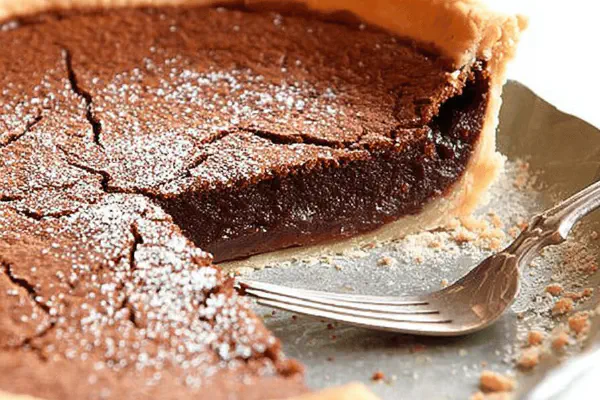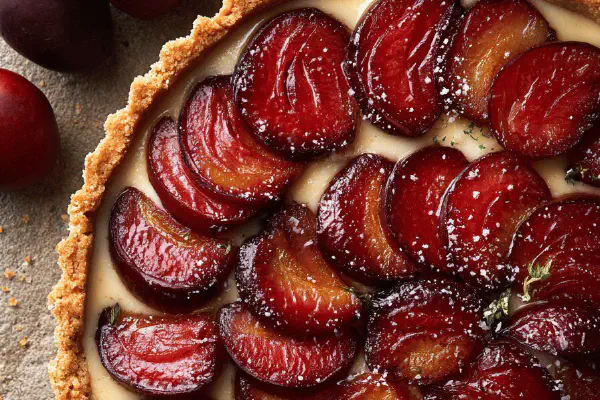Lemon Pineapple Tartelettes

By Emma
Certified Culinary Professional
Ingredients
Crust
- 133 g (1 cup) all-purpose flour
- 45 g (1/3 cup) powdered sugar
- 1 ml (1/4 tsp) salt
- 95 g (7 tbsp) unsalted cold butter, cubed
- 22 ml (1 1/2 tbsp) ice water
Lemon-Pineapple Filling
- 100 g (2/3 cup) fresh pineapple, diced
- 85 g (1/3 cup) sugar
- 40 ml (3 tbsp) fresh lemon juice
- 20 ml (1 tbsp) pineapple juice concentrate
- 2 eggs
- 15 ml (1 tbsp) cornstarch
- 15 ml (1 tbsp) arrowroot powder
- 40 g (3 tbsp) unsalted butter, cubed
- 1 tsp freshly grated ginger (optional)
- Thin slices of 1/4 fresh pineapple for garnish
- 18 slender lemon zest strips (optional)
Meringue
- 2 egg whites
- Pinch cream of tartar or white vinegar (optional)
- 55 g (1/4 cup) superfine sugar
About the ingredients
Method
Crust
- Pulse flour, powdered sugar, salt in food processor briefly to combine. Add butter cubes, pulse in short bursts until pea-sized crumbs form. The key: don't overwork; pockets of butter create flakiness. Pour in ice water slowly while pulsing just until dough starts to clump; too much moisture yields tough crust.
- Gather dough on floured surface, knead lightly about 20 seconds to homogenize. Shape into log, cut into 8 equal pieces. If dough feels sticky, chill 10 mins; too hard, let soften 5 mins before rolling.
- Roll each piece on lightly floured board into 12 cm disks, aiming even thickness around 3 mm. Press into tartlet pans with removable bottoms about 9-10 cm diameter. Trim edges roughly with fingers or knife; jagged is OK. Dock base with fork to prevent bubbling. Chill tartelettes 40 mins if fridge space; if rushed, freeze 8-10 mins only, the cold sets fats.
- Preheat oven to 195 °C (385 °F), middle rack. Use weights or dried beans on parchment to blind bake to preserve shape; bake 15-18 mins until crust turns firm, pale golden at edges. Listen for a slight crisp crackle when tapping crust; signals readiness. Cool completely on wire rack — at least 50 mins. Do not skip cooling, or filling heat will soften crust.
Filling
- In blender, blitz fresh pineapple, sugar, lemon juice, pineapple concentrate, and grated ginger until smooth. Warn: ginger adds warmth, but too much can overpower; add cautiously.
- Whisk in eggs, cornstarch, arrowroot. Arrowroot adds clarity to custard, making texture silkier, less gummy than cornstarch alone. Blend just enough to smooth but not whip in air.
- Transfer mixture to medium saucepan, cook over medium-low heat. Constantly whisk; custard thickens gradually, bubbling when ready — looks glossy, coats spoon thickly. About 6-8 mins. Boiling rapidly ruins texture; control heat.
- Remove pan immediately. Stir butter cubes in swiftly; melt into custard for richness and shine. If lumpy, strain through fine sieve into bowl. Spoon evenly into cooled crusts. Refrigerate minimum 110 mins to firm completely. Filling should feel slightly springy to touch, not liquidy.
- Arrange thin pineapple slices atop each tartlet gently. Reserve lemon zest strips for garnish.
Meringue
- Set up bain-marie: small pot with water simmering lightly, not boiling. Combine egg whites and sugar in heatproof bowl. Slowly whisk over heat until sugar dissolves and temp hits about 60 °C (140 °F). Aged bakers often test sugar dissolve by rubbing between fingers — no grit means ready.
- Remove bowl promptly. Add cream of tartar or splash vinegar to stabilize proteins, optional but prevents weep.
- Beat with electric mixer on high. Starts glossy, stiff peaks form after about 5-7 mins. Meringue will hold shape firmly; you want stiff but shiny peaks, not dry or grainy.
- Fill pastry bag fitted with plain 1 cm round tip. Pipe small peaks or generous domes over custard. Carefully sprinkle lemon zest strips artistically on top.
- Place tartelettes briefly under hot broiler 1-2 mins, keep eye on meringue. Bubbles pop, color turns warm golden. Smell toasted marshmallow, buzz of quick heat. Remove once peaks are browned — else bitter burnt notes. Cool slightly before serving.
- Store leftovers refrigerated, meringue best fresh day of baking.
Tips & Troubleshooting
- If dough cracks, warm hands and press edges gently; cold flour brand contributes. Over-mixing crust ruins texture—watch pulse times.
- Lemon-pineapple mix can be made a day ahead; just strain and keep chilled.
- Meringue can be temperamental: room temp egg whites whip better. Make sure no yolk traces or grease.
- If cool air is dry, meringue dries faster—serve quickly for soft peaks.
- For dairy-free, sub butter with vegan margarine in crust and filling, but texture changes—more crumbly crust, less creamy filling.
- Keeping crusts chilled before baking and after reduces shrinking and sogginess.
- Using arrowroot along with cornstarch smooths filling texture. Bacon grease instead of butter is obviously a no—keep it balanced.
- Pineapple slices fresh, not canned, avoid excess juice runoff that sogs crust.
- Meringue can be piped fancifully; I like rustic waves or little mountain tops. Toasting is crucial — no color, no crunch.
Cooking tips
Chef's notes
- 💡 Pulse crust ingredients briefly, don't overwork; pea-sized butter crumbs critical. Ice water added slow, dough just clumps. Overmoisture equals tough dough. Chill dough if sticky, soften if too firm. Roll to consistent 3 mm thickness. Dock tart base to keep bubbles out. Blind bake with weights. Bake till edges pale gold, slight crisp crackle audible. Cooling crust fully is non-negotiable to avoid sogginess under custard.
- 💡 For filling, blitz pineapple, sugar, lemon juice, concentrate, ginger gently. Ginger punchy; little goes far, add cautiously. Eggs, cornstarch, arrowroot folded in, arrowroot cuts gummy texture, keeps silky. Heat custard low-medium, constant whisk keeps smooth. Look for bubbles and thick spoon coat. Butter stirred in last for shine and richness. Strain if lumps. Chill minimum 110 mins for springy set. Thin pineapple slices fresh and placed gently to prevent juice runoff.
- 💡 Meringue needs gradual heating over bain-marie, sugar fully dissolved at 60 °C. Test sugar by feel, no grit left. Add cream of tartar or vinegar optional but stops weep. Whip off heat till stiff, shiny peaks form; overbeating causes dryness and graininess. Pipe with simple round tip; make peaks or domes. Lemon zest fine strips add bright spark sprinkled top. Broil quick 1-2 mins until warm golden, seeing toasted marshmallow aroma. Don’t burn; bitter spoils everything. Cool slightly before serving.
- 💡 If crust cracks, warm hands gently press edges. Too cold flour causes dryness. Watch pulses when mixing; overmixing ruins flakiness. Dough can chill longer if needed but keep cold till rolling. Using vegan margarine for dairy-free shifts texture — crust more crumbly, filling less creamy. Pineapple slices fresh not canned — excess juice sogs crust fast. Arrowroot plus cornstarch smooths filling texture better than cornstarch alone. Blind bake with dried beans or baking weights foolproof shape hold.
- 💡 Filling can be made ahead a day; strain then fridge tightly covered. Meringue better same day; dries fast in dry air. Room temp egg whites whip easier; no yolk traces allowed or foam breaks. Watch oven and heat carefully; times vary. Toast meringue until just golden, bubbles popping, not dark spots. Cooling crust fully before filling allows crisp texture; shortcuts cause soft bottoms. Use slender lemon zest strips for artistic bright punch but not mandatory. Practice cutting sound: crisp versus yielding signals done.
Common questions
How to avoid soggy crust?
Cool crust fully before adding filling. Don’t skip chilling. Blind bake with weights so shape holds. Excess moisture from fresh pineapple slices drains if too thick. Dock base foil to stop bubbles. Oven hot, crust edges pale gold, crisp crackle sound helps timing.
Can I skip pineapple juice concentrate?
Yes. Use extra lemon juice instead. Concentrate adds depth, richer flavor. Fresh juice only changes texture a bit but filling stays stable. Arrowroot plus cornstarch thickens without gummy mouthfeel. Ginger optional punch if you like subtle heat; leave out for simple tartness.
Meringue won’t peak stiff?
Check egg white temperature. Room temp whites whip faster. Make sure no yolk or grease. Heat sugar mix enough to dissolve fully at 60 °C, test by feeling sugar between fingers. Adding cream of tartar or splash vinegar helps stabilize foam. Whip off heat until peak forms; timing varies. Overwhip dries meringue; underwhip no hold.
Best storage for leftovers?
Refrigerate meringue tartelettes tightly wrapped. Meringue best fresh same day; dries and loses texture next day. If crust softens, crisping it back isn’t easy. Filling keeps 2-3 days chilled sealed. No freezer recommended — meringue texture suffers. If planning ahead, fill shells day before, pipe meringue last minute then broil.



